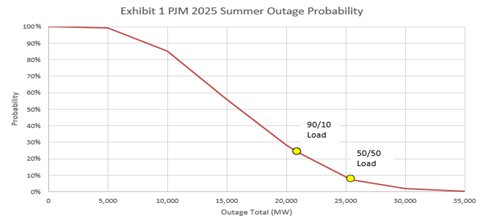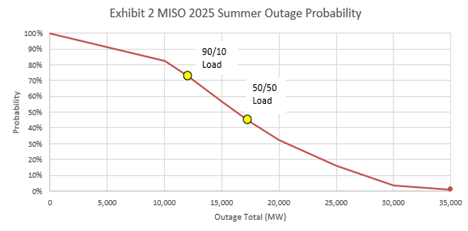ReliabilityFirst 2025 Summer Reliability Assessment
 By Tim Fryfogle, Principal Engineer – Resources, Engineering and System Performance
By Tim Fryfogle, Principal Engineer – Resources, Engineering and System Performance
ReliabilityFirst annually conducts seasonal reliability assessments, analyzing resource adequacy in our region using data provided by MISO and PJM. The Summer Reliability Assessment is published each June at the onset of the period of warmer weather experienced across the summer months in the RF region.
ReliabilityFirst (RF) projects both the MISO and PJM areas to have adequate resources to serve normal electric demand in the upcoming summer season, including during expected periods in which certain generation resources become unavailable. This analysis is based on data provided by MISO and PJM, which we use to perform our annual summer resource adequacy assessment.
While these 50/50 demand forecasts project MISO and PJM to have adequate resources to satisfy their respective planning reserve requirements, if resource outages and/or demand are experienced beyond the established projections, there is an increased likelihood that corrective actions (like Load Modifying Resources and Operating Reserves) would need to be utilized to serve forecasted load. The 50/50 demand forecast projects a 50% likelihood that demand exceeds projected load and 50% likelihood that it is below.
This risk of resource unavailability requiring corrective actions to be taken is elevated in the MISO area compared to the PJM area. When resource outages and/or demand are experienced beyond the established projections, PJM is at low risk while MISO is at an elevated risk for the summer of 2025.
MISO does anticipate issuing Maximum Generation alerts to call on their demand response programs. These alerts provide an early warning that system conditions may require the use of MISO’s generation emergency procedures. These resources are only eligible to be used after all other online callable and dispatchable generation has maxed out.
The availability of MISO wind energy resources will also play a key role in determining whether MISO will need assistance from external (non-firm) resources during periods of more extreme demand levels. MISO has more than 31,000 MW of installed wind capacity, however historically these resources produce approximately 5,616 MW of on-peak capacity.
Capacity and reserves
PJM’s planning reserve margin requirement is 17.7% for the 2025 planning year, while its forecasted reserve margin comes in above that figure at 24.7%. As a result, PJM is considered a low risk of electricity supply shortages this summer.
MISO’s planning reserve margin requirement is 15.7% for the 2025 planning year. Its forecasted reserve margin is above that value at 24.7%, meaning the MISO area has sufficient resources to meet the anticipated demand this summer period. However, as discussed in the next section of this article, MISO does have an increased likelihood of capacity shortfalls if unplanned outages and demand are higher than anticipated.
Since PJM and MISO are both projected to have adequate resources to satisfy their respective forecasted reserve margin requirements, the RF footprint as a whole is projected to have sufficient resources for the 2025 summer period.
Likelihood of generation unavailability
RF’s summer assessment also evaluated the likelihood associated with different levels of generation unavailability for PJM and MISO¹, shown in Exhibits 1 and 2 below².
 Exhibit 1 shows the probability of PJM’s outage likelihood based on different generation outage levels within PJM. The yellow load dots indicate where available resources are no longer sufficient to serve the projected load, including their use of demand response and operating reserves.
Exhibit 1 shows the probability of PJM’s outage likelihood based on different generation outage levels within PJM. The yellow load dots indicate where available resources are no longer sufficient to serve the projected load, including their use of demand response and operating reserves.
The 90/10 demand forecast is a more extreme load profile than the 50/50 demand forecast. Looking at Exhibit 1, for the 90/10 demand forecast, it is projecting a 22% chance that demand exceeds extreme load which may require the operator to begin mitigating actions to prevent firm load shed (i.e., this includes using operating reserves, interchange transactions, and demand response).
For PJM’s 50/50 demand forecast, 25,500 MW of generation unavailability may require operator mitigating actions. This analysis indicates that there’s a very low likelihood (less than 10%) of this amount of generation outages occurring, making PJM a low risk for the upcoming summer.
 Exhibit 2 shows MISO’s summer outage likelihood based on different generation outage levels. The 90/10 demand forecast projects a greater than 70% chance that demand exceeds extreme load which may require the operator to begin mitigating actions to prevent firm load shed.
Exhibit 2 shows MISO’s summer outage likelihood based on different generation outage levels. The 90/10 demand forecast projects a greater than 70% chance that demand exceeds extreme load which may require the operator to begin mitigating actions to prevent firm load shed.
For MISO’s 50/50 demand forecast, this analysis indicates there’s a nearly 50% chance that demand exceeds load requiring the operator to begin mitigating actions to prevent firm load shed. Since there is a lower amount of generator outages that need to occur before MISO operators need to take corrective action to stop firm load shed, MISO is at an elevated risk for the upcoming summer.
Footnotes:
-
This analysis uses historical GADS data from a rolling five-year period, which provided a range of outages that occur during the summer period (i.e., May through September) of 2020 through 2024 (note: the distribution of random outages used for this assessment is not linear throughout the range of outages observed).
-
When reviewing Exhibits 1 and 2, the outage total across the horizontal axis of the graph is the number of outages that could occur during the five-year timeframe examined based on historical GADS data. The probabilities on the vertical axis are not based on a true statistical analysis of the available daily random outage data. Instead, these values represent the proportion of outages compared to the total resources available, then determines how often this proportion occurred within the five-year historical summer period.

